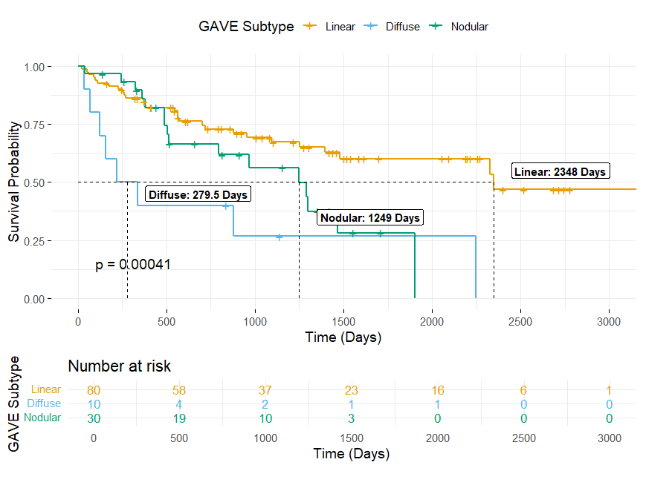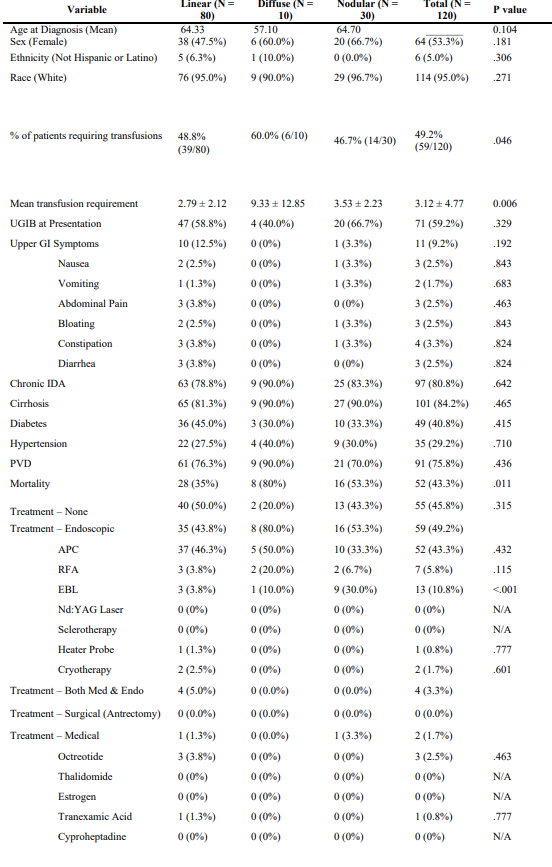Oral Paper Presentation
Annual Scientific Meeting
Session: Plenary Session 3B: Luminal GI / Endoscopy / Pancreas
50 - Clinical Characteristics, Management, and Survival Outcomes Differ Across Morphological Subtypes of Gastric Antral Vascular Ectasia (GAVE): A Retrospective Comparative Study
Tuesday, October 28, 2025
2:55 PM - 3:05 PM PDT
Location: North Ballroom 120BC
.jpg)
Moataz Aboeldahb, MBBCh
Mayo Clinic College of Medicine and Science
Rochester, MN
Presenting Author(s)
Moataz Aboeldahb, MBBCh1, Riya Gupta, MBBS2, Hadi Khaled. Abou Zeid, MD2, Anjali Rajagopal, MBBS3, Xiao Jing Wang, MD2
1Mayo Clinic College of Medicine and Science, Rochester, MN; 2Mayo Clinic, Rochester, MN; 3University of Connecticut Health Center, Farmington, CT
Introduction: Gastric Antral Vascular Ectasia (GAVE) presents in morphologic subtypes—Linear, Diffuse, and Nodular—with unclear differences in outcomes. This study evaluates subtype-specific differences in demographics, comorbidities, clinical presentation, transfusion needs, treatment patterns, and overall survival.
Methods: We retrospectively analyzed 120 patients with endoscopically confirmed GAVE divided by subtype: Linear (n=80), Diffuse (n=10), and Nodular (n=30). Demographics, GI symptoms, comorbidities, treatment modalities, transfusion burden, and survival were compared using chi-square and Kaplan-Meier survival analysis. The primary outcome was overall survival; secondary outcomes included symptom burden, transfusion burden, and treatment approach.
Results: Age at diagnosis, sex, race/ethnicity, and comorbidities did not significantly differ among GAVE subtypes. Mortality was highest in the Diffuse group (80%) compared to Linear (35%) and Nodular (53.3%) (p = 0.011). Kaplan-Meier survival analysis demonstrated significant differences in median survival by subtype: 279.5 days (~0.8 years) for Diffuse, 1249 days (~3.4 years) for Nodular, and 2348 days (~6.4 years) for Linear (p < 0.001). Upper GI symptoms were infrequently noted overall (9.2%), with symptoms documented only in the Linear and Nodular groups. Transfusion burden varied significantly across subtypes, with the Diffuse group having the highest percentage of patients requiring transfusion (60.0% vs. 48.8% for Linear and 46.7% for Nodular; p = 0.046). Among those who were transfused, mean transfusion requirements differed significantly by subtype, with the Diffuse group exhibiting the highest burden (9.3 units), compared to 2.8 units in the Linear group and 3.5 units in the Nodular group (p = 0.006). About half of patients underwent endoscopic therapy with modalities differing among groups: Endoscopic Band Ligation (EBL) was more commonly utilized in the Nodular group (p < 0.001), while Argon Plasma Coagulation (APC) and Radiofrequency Ablation (RFA) usage did not differ significantly (p = 0.432 and p = 0.115, respectively), consistent with published recommendations.
Discussion: Despite similar demographic and comorbidity profiles, survival and transfusion needs differed markedly by GAVE subtype. Diffuse GAVE was associated with significantly shorter survival and a higher transfusion burden. Morphologic subtype provides prognostic value and should inform patient counseling.

Figure: Figue1

Figure: Table1
Disclosures:
Moataz Aboeldahb indicated no relevant financial relationships.
Riya Gupta indicated no relevant financial relationships.
Hadi Abou Zeid indicated no relevant financial relationships.
Anjali Rajagopal indicated no relevant financial relationships.
Xiao Jing Wang indicated no relevant financial relationships.
Moataz Aboeldahb, MBBCh1, Riya Gupta, MBBS2, Hadi Khaled. Abou Zeid, MD2, Anjali Rajagopal, MBBS3, Xiao Jing Wang, MD2, 50, Clinical Characteristics, Management, and Survival Outcomes Differ Across Morphological Subtypes of Gastric Antral Vascular Ectasia (GAVE): A Retrospective Comparative Study, ACG 2025 Annual Scientific Meeting Abstracts. Phoenix, AZ: American College of Gastroenterology.
1Mayo Clinic College of Medicine and Science, Rochester, MN; 2Mayo Clinic, Rochester, MN; 3University of Connecticut Health Center, Farmington, CT
Introduction: Gastric Antral Vascular Ectasia (GAVE) presents in morphologic subtypes—Linear, Diffuse, and Nodular—with unclear differences in outcomes. This study evaluates subtype-specific differences in demographics, comorbidities, clinical presentation, transfusion needs, treatment patterns, and overall survival.
Methods: We retrospectively analyzed 120 patients with endoscopically confirmed GAVE divided by subtype: Linear (n=80), Diffuse (n=10), and Nodular (n=30). Demographics, GI symptoms, comorbidities, treatment modalities, transfusion burden, and survival were compared using chi-square and Kaplan-Meier survival analysis. The primary outcome was overall survival; secondary outcomes included symptom burden, transfusion burden, and treatment approach.
Results: Age at diagnosis, sex, race/ethnicity, and comorbidities did not significantly differ among GAVE subtypes. Mortality was highest in the Diffuse group (80%) compared to Linear (35%) and Nodular (53.3%) (p = 0.011). Kaplan-Meier survival analysis demonstrated significant differences in median survival by subtype: 279.5 days (~0.8 years) for Diffuse, 1249 days (~3.4 years) for Nodular, and 2348 days (~6.4 years) for Linear (p < 0.001). Upper GI symptoms were infrequently noted overall (9.2%), with symptoms documented only in the Linear and Nodular groups. Transfusion burden varied significantly across subtypes, with the Diffuse group having the highest percentage of patients requiring transfusion (60.0% vs. 48.8% for Linear and 46.7% for Nodular; p = 0.046). Among those who were transfused, mean transfusion requirements differed significantly by subtype, with the Diffuse group exhibiting the highest burden (9.3 units), compared to 2.8 units in the Linear group and 3.5 units in the Nodular group (p = 0.006). About half of patients underwent endoscopic therapy with modalities differing among groups: Endoscopic Band Ligation (EBL) was more commonly utilized in the Nodular group (p < 0.001), while Argon Plasma Coagulation (APC) and Radiofrequency Ablation (RFA) usage did not differ significantly (p = 0.432 and p = 0.115, respectively), consistent with published recommendations.
Discussion: Despite similar demographic and comorbidity profiles, survival and transfusion needs differed markedly by GAVE subtype. Diffuse GAVE was associated with significantly shorter survival and a higher transfusion burden. Morphologic subtype provides prognostic value and should inform patient counseling.

Figure: Figue1

Figure: Table1
Disclosures:
Moataz Aboeldahb indicated no relevant financial relationships.
Riya Gupta indicated no relevant financial relationships.
Hadi Abou Zeid indicated no relevant financial relationships.
Anjali Rajagopal indicated no relevant financial relationships.
Xiao Jing Wang indicated no relevant financial relationships.
Moataz Aboeldahb, MBBCh1, Riya Gupta, MBBS2, Hadi Khaled. Abou Zeid, MD2, Anjali Rajagopal, MBBS3, Xiao Jing Wang, MD2, 50, Clinical Characteristics, Management, and Survival Outcomes Differ Across Morphological Subtypes of Gastric Antral Vascular Ectasia (GAVE): A Retrospective Comparative Study, ACG 2025 Annual Scientific Meeting Abstracts. Phoenix, AZ: American College of Gastroenterology.
